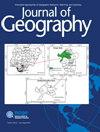ポータブル蛍光エックス線分析装置による津波堆積物の簡易判別手法の検討
IF 1.8
3区 地球科学
Q1 GEOGRAPHY
引用次数: 2
Abstract
To improve a method for geochemically discriminating paleotsunami deposits, a quantitative analysis of major and trace elements in boring cores from the Shizuoka plain on the Pacific coast of central Japan was performed using a portable energy dispersive X-ray fluorescence spectrometry system (portable XRF). Geochemical approaches using a portable XRF contribute to studies on simple and rapid methods for detecting paleotsunami deposits. Calibration curves for quantitative analyses were prepared using 25 geochemical standard samples. Geochemical characteristics of paleotsunami deposits (ca. 1000, 3500, and 4000 cal BP) from the Shizuoka plain were obtained. Most of the quantitative data collected with the portable XRF were good agreement with reported values measured with stationary-type energy dispersive XRF in previous studies. Therefore, a portable XRF was applied in geochemical studies of samples from the Shizuoka plain. Relatively high Si/Ti, Ca/Ti, and Sr/Ti atomic ratios were observed in paleotsunami deposits from layers aged ca. 1000, 3500, and 4000 cal BP. Moreover, relatively high Cr/Ti ratios were found in lower paleotsunami deposits (ca. 4000 cal BP). Fe/Ti and S/Ti ratios increased in peaty clay layers just below the paleotsunami deposits in the core. On the other hand, Cl was not detected in the cores. Most of the paleotsunami deposits were distinguished from other layers in the cores using a cluster analysis with the portable XRF data. Therefore, a portable XRF is useful for characterizing paleotsunami deposits from the Shizuoka plain.便携式荧光x线分析装置对海啸沉积物的简易判别方法的研究
为了改进古海啸沉积地球化学鉴别方法,采用便携式能量色散x射线荧光光谱法(portable XRF)对日本中部太平洋沿岸静冈平原钻孔岩心中的主元素和微量元素进行了定量分析。使用便携式XRF的地球化学方法有助于研究简单快速的检测古海啸沉积物的方法。用25个地球化学标准样品制备了定量分析的校准曲线。获得了静冈平原古海啸沉积(约1000、3500和4000 cal BP)的地球化学特征。便携式XRF采集的定量数据与以往研究中稳态能量色散XRF测量的结果吻合良好。因此,将便携式XRF应用于静冈平原样品的地球化学研究。古海啸沉积物的Si/Ti、Ca/Ti和Sr/Ti原子比均较高,年龄分别为1000、3500和4000 cal BP。此外,在较低的古海啸沉积(约4000 cal BP)中发现了较高的Cr/Ti比值。岩心古海啸沉积物下方泥炭黏土层Fe/Ti和S/Ti比值增加。另一方面,在岩心中未检测到Cl。利用便携式XRF数据进行聚类分析,将大部分古海啸沉积与岩心中的其他层区分开。因此,便携式XRF对静冈平原古海啸沉积物的表征是有用的。
本文章由计算机程序翻译,如有差异,请以英文原文为准。
求助全文
约1分钟内获得全文
求助全文
来源期刊

Journal of Geography
GEOGRAPHY-
CiteScore
4.90
自引率
6.50%
发文量
12
期刊介绍:
Journal of Geography is the journal of the National Council for Geographic Education. The Journal of Geography provides a forum to present innovative approaches to geography research, teaching, and learning. The Journal publishes articles on the results of research, instructional approaches, and book reviews.
 求助内容:
求助内容: 应助结果提醒方式:
应助结果提醒方式:


